CoordinateSystem¶
Qualified name: manim.mobject.graphing.coordinate\_systems.CoordinateSystem
- class CoordinateSystem(x_range=None, y_range=None, x_length=None, y_length=None, dimension=2)[source]¶
基类:
objectAxes 和 NumberPlane 的抽象基类。
示例
示例: CoordSysExample ¶
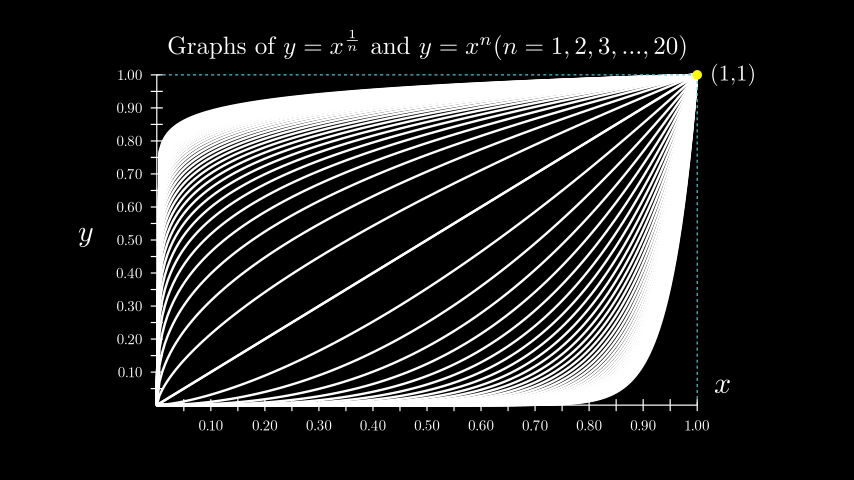
from manim import * class CoordSysExample(Scene): def construct(self): # the location of the ticks depends on the x_range and y_range. grid = Axes( x_range=[0, 1, 0.05], # step size determines num_decimal_places. y_range=[0, 1, 0.05], x_length=9, y_length=5.5, axis_config={ "numbers_to_include": np.arange(0, 1 + 0.1, 0.1), "font_size": 24, }, tips=False, ) # Labels for the x-axis and y-axis. y_label = grid.get_y_axis_label("y", edge=LEFT, direction=LEFT, buff=0.4) x_label = grid.get_x_axis_label("x") grid_labels = VGroup(x_label, y_label) graphs = VGroup() for n in np.arange(1, 20 + 0.5, 0.5): graphs += grid.plot(lambda x: x ** n, color=WHITE) graphs += grid.plot( lambda x: x ** (1 / n), color=WHITE, use_smoothing=False ) # Extra lines and labels for point (1,1) graphs += grid.get_horizontal_line(grid @ (1, 1, 0), color=BLUE) graphs += grid.get_vertical_line(grid @ (1, 1, 0), color=BLUE) graphs += Dot(point=grid @ (1, 1, 0), color=YELLOW) graphs += Tex("(1,1)").scale(0.75).next_to(grid @ (1, 1, 0)) title = Title( # spaces between braces to prevent SyntaxError r"Graphs of $y=x^{ {1}\over{n} }$ and $y=x^n (n=1,2,3,...,20)$", include_underline=False, font_size=40, ) self.add(title, graphs, grid, grid_labels)
class CoordSysExample(Scene): def construct(self): # the location of the ticks depends on the x_range and y_range. grid = Axes( x_range=[0, 1, 0.05], # step size determines num_decimal_places. y_range=[0, 1, 0.05], x_length=9, y_length=5.5, axis_config={ "numbers_to_include": np.arange(0, 1 + 0.1, 0.1), "font_size": 24, }, tips=False, ) # Labels for the x-axis and y-axis. y_label = grid.get_y_axis_label("y", edge=LEFT, direction=LEFT, buff=0.4) x_label = grid.get_x_axis_label("x") grid_labels = VGroup(x_label, y_label) graphs = VGroup() for n in np.arange(1, 20 + 0.5, 0.5): graphs += grid.plot(lambda x: x ** n, color=WHITE) graphs += grid.plot( lambda x: x ** (1 / n), color=WHITE, use_smoothing=False ) # Extra lines and labels for point (1,1) graphs += grid.get_horizontal_line(grid @ (1, 1, 0), color=BLUE) graphs += grid.get_vertical_line(grid @ (1, 1, 0), color=BLUE) graphs += Dot(point=grid @ (1, 1, 0), color=YELLOW) graphs += Tex("(1,1)").scale(0.75).next_to(grid @ (1, 1, 0)) title = Title( # spaces between braces to prevent SyntaxError r"Graphs of $y=x^{ {1}\over{n} }$ and $y=x^n (n=1,2,3,...,20)$", include_underline=False, font_size=40, ) self.add(title, graphs, grid, grid_labels)方法
为坐标轴添加标签。
返回在特定x值处,绘制曲线的切线与x轴的夹角。
coords_to_point()的缩写。coords_to_point创建一个带标签的三角形标记,其中包含一条从x轴到给定x值处曲线的垂直线。
返回一个表示所传递图形下方区域的
Polygon对象。get_axesget_axisget_axis_labels为所传递的图形创建一个位置恰当的标签,可选择添加一个点。
一条从y轴到场景中给定点的水平线。
返回一条从给定轴到场景中一个点的直线。
生成从坐标轴到某点的水平线和垂直线。
获取
Axes的原点。为给定曲线生成一组黎曼矩形的
VGroup对象。创建两条代表dx和df的线,以及dx和df的标签,和
一条从x轴到场景中给定点的垂直线。
获取从x轴到曲线的多条线。
get_x_axis生成x轴标签。
get_x_unit_sizeget_y_axis生成y轴标签。
get_y_unit_sizeget_z_axis根据给定的x值,返回图上点的轴相对坐标的元组。
返回
graph上对应于x值的点的坐标。point_to_coords()的缩写。根据函数生成曲线。
绘制反导数图。
返回所传递图形的导数曲线。
创建隐函数的曲线。
一条参数曲线。
极坐标图。
根据函数生成曲面。
point_to_coords从点获取极坐标。
从极坐标获取一个点。
polar_to_point()的缩写。point_to_polar()的缩写。返回在特定x值处,绘制曲线的切线的斜率。
- 参数:
x_range (Sequence[float] | None)
y_range (Sequence[float] | None)
x_length (float | None)
y_length (float | None)
dimension (int)
- add_coordinates(*axes_numbers, **kwargs)[source]¶
为坐标轴添加标签。创建后,使用
Axes.coordinate_labels访问坐标。- 参数:
axes_numbers (Iterable[float] | None | dict[float, str | float | Mobject]) – 要添加到坐标轴的数字。使用
None表示具有默认标签的坐标轴。kwargs (Any)
- 返回类型:
自身
示例
ax = ThreeDAxes() x_labels = range(-4, 5) z_labels = range(-4, 4, 2) ax.add_coordinates( x_labels, None, z_labels ) # default y labels, custom x & z labels ax.add_coordinates(x_labels) # only x labels
您还可以使用字典来精确控制标签的位置和值。
ax = Axes(x_range=[0, 7]) x_pos = [x for x in range(1, 8)] # strings are automatically converted into a Tex mobject. x_vals = [ "Monday", "Tuesday", "Wednesday", "Thursday", "Friday", "Saturday", "Sunday", ] x_dict = dict(zip(x_pos, x_vals)) ax.add_coordinates(x_dict)
- angle_of_tangent(x, graph, dx=1e-08)[source]¶
返回在特定x值处,绘制曲线的切线与x轴的夹角。
- 参数:
x (float) – 切线必须与曲线相切的x值。
graph (ParametricFunction) – 用于计算切线的
ParametricFunction。dx (float) – 用于确定曲线切线角度的x的变化量。
- 返回:
曲线切线的角度。
- 返回类型:
浮点数
示例
ax = Axes() curve = ax.plot(lambda x: x**2) ax.angle_of_tangent(x=3, graph=curve) # 1.4056476493802699
- c2p(*coords)[source]¶
coords_to_point()的缩写。- 参数:
coords (float | Sequence[float] | Sequence[Sequence[float]] | ndarray)
- 返回类型:
ndarray
- get_T_label(x_val, graph, label=None, label_color=None, triangle_size=0.25, triangle_color=ManimColor('#FFFFFF'), line_func=<class 'manim.mobject.geometry.line.Line'>, line_color=ManimColor('#FFFF00'))[source]¶
创建一个带标签的三角形标记,其中包含一条从x轴到给定x值处曲线的垂直线。
- 参数:
x_val (float) – 沿着曲线上构建标签、线和三角形的位置。
graph (ParametricFunction) – 用于构建标签的
ParametricFunction。label (float | str | Mobject | None) – 垂直线和三角形的标签。
label_color (ParsableManimColor | None) – 标签的颜色。
triangle_size (float) – 三角形的大小。
triangle_color (ParsableManimColor | None) – 三角形的颜色。
line_func (type[Line]) – 用于构建垂直线的函数。
line_color (ParsableManimColor) – 垂直线的颜色。
- 返回:
标签、三角形和垂直线mobject组成的
VGroup对象。- 返回类型:
示例
示例: TLabelExample ¶
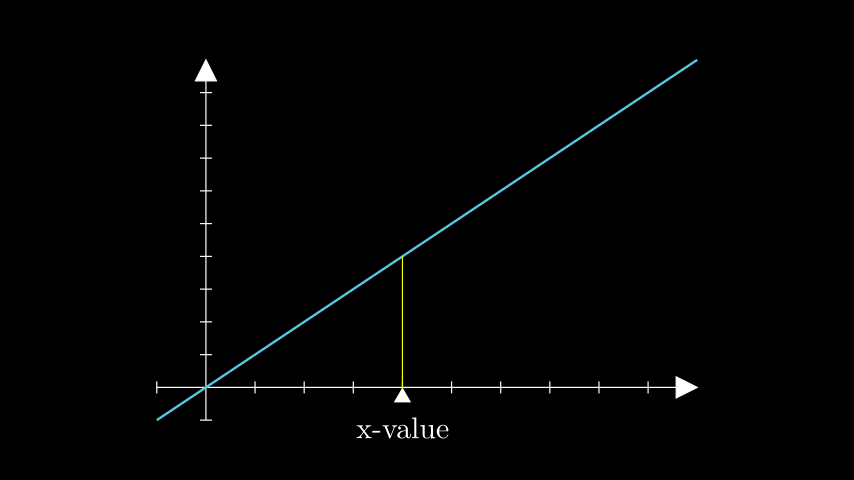
from manim import * class TLabelExample(Scene): def construct(self): # defines the axes and linear function axes = Axes(x_range=[-1, 10], y_range=[-1, 10], x_length=9, y_length=6) func = axes.plot(lambda x: x, color=BLUE) # creates the T_label t_label = axes.get_T_label(x_val=4, graph=func, label=Tex("x-value")) self.add(axes, func, t_label)
class TLabelExample(Scene): def construct(self): # defines the axes and linear function axes = Axes(x_range=[-1, 10], y_range=[-1, 10], x_length=9, y_length=6) func = axes.plot(lambda x: x, color=BLUE) # creates the T_label t_label = axes.get_T_label(x_val=4, graph=func, label=Tex("x-value")) self.add(axes, func, t_label)
- get_area(graph, x_range=None, color=(ManimColor('#58C4DD'), ManimColor('#83C167')), opacity=0.3, bounded_graph=None, **kwargs)[source]¶
返回一个表示所传递图形下方区域的
Polygon对象。- 参数:
graph (ParametricFunction) – 需要获取面积的图形/曲线。
x_range (tuple[float, float] | None) – 区域的x值最小和最大范围。
x_range = [x_min, x_max]。color (ParsableManimColor | Iterable[ParsableManimColor]) – 区域的颜色。如果提供颜色列表,则创建渐变色。
opacity (float) – 区域的不透明度。
bounded_graph (ParametricFunction) – 如果指定了第二个
graph,则包围两条曲线之间的区域。kwargs (Any) – 传递给
Polygon的额外参数。
- 返回:
表示该区域的
Polygon对象。- 返回类型:
- 抛出:
ValueError – 当x范围不匹配时(无论是区域的x范围、图形的x范围还是bounded_graph的x范围)。
示例
示例: GetAreaExample ¶
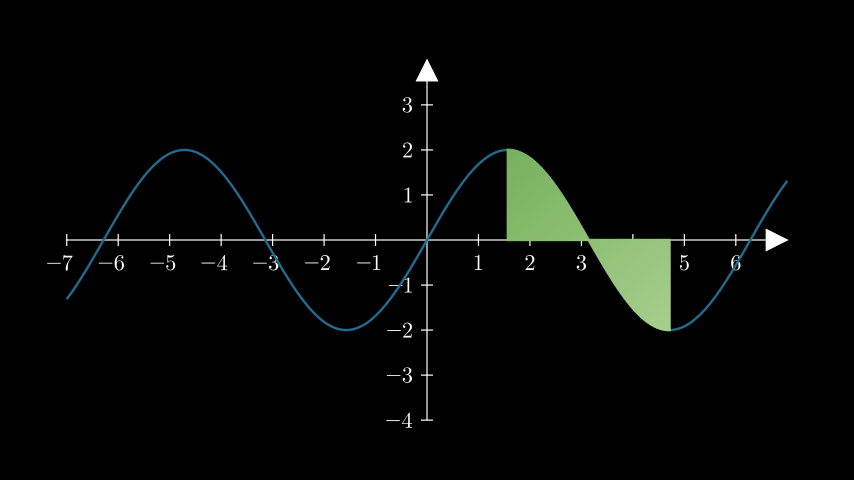
from manim import * class GetAreaExample(Scene): def construct(self): ax = Axes().add_coordinates() curve = ax.plot(lambda x: 2 * np.sin(x), color=DARK_BLUE) area = ax.get_area( curve, x_range=(PI / 2, 3 * PI / 2), color=(GREEN_B, GREEN_D), opacity=1, ) self.add(ax, curve, area)
class GetAreaExample(Scene): def construct(self): ax = Axes().add_coordinates() curve = ax.plot(lambda x: 2 * np.sin(x), color=DARK_BLUE) area = ax.get_area( curve, x_range=(PI / 2, 3 * PI / 2), color=(GREEN_B, GREEN_D), opacity=1, ) self.add(ax, curve, area)
- get_graph_label(graph, label='f(x)', x_val=None, direction=array([1., 0., 0.]), buff=0.25, color=None, dot=False, dot_config=None)[source]¶
为所传递的图形创建一个位置恰当的标签,可选择添加一个点。
- 参数:
graph (ParametricFunction) – 曲线。
label (float | str | Mobject) – 函数曲线的标签。对于
str和float输入,默认为MathTex。x_val (float | None) – 沿曲线定位标签的x值。
direction (Sequence[float]) – 标签相对于曲线的笛卡尔位置 —>
LEFT,RIGHT。buff (float) – 曲线与标签之间的距离。
color (ParsableManimColor | None) – 标签的颜色。默认为曲线的颜色。
dot (bool) – 是否在图上的点添加一个点。
dot_config (dict[str, Any] | None) – 传递给
Dot的额外参数。
- 返回:
已定位的标签和
Dot(如果适用)。- 返回类型:
Mobject
示例
示例: GetGraphLabelExample ¶
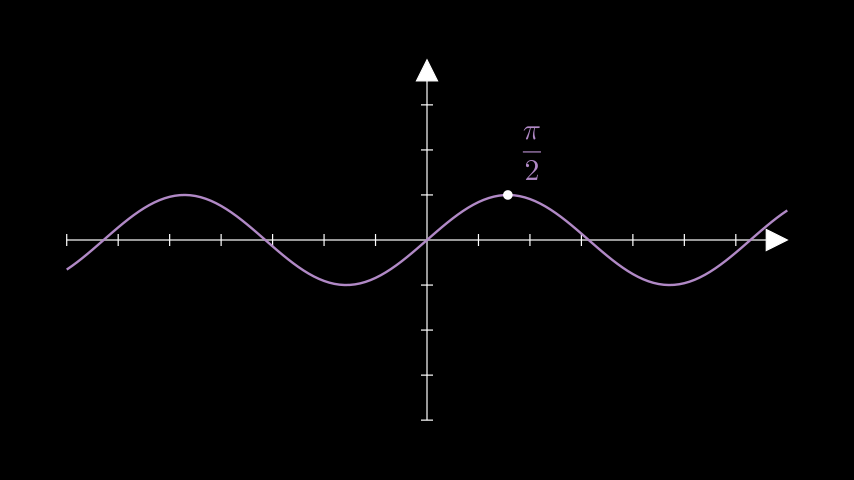
from manim import * class GetGraphLabelExample(Scene): def construct(self): ax = Axes() sin = ax.plot(lambda x: np.sin(x), color=PURPLE_B) label = ax.get_graph_label( graph=sin, label= MathTex(r"\frac{\pi}{2}"), x_val=PI / 2, dot=True, direction=UR, ) self.add(ax, sin, label)
class GetGraphLabelExample(Scene): def construct(self): ax = Axes() sin = ax.plot(lambda x: np.sin(x), color=PURPLE_B) label = ax.get_graph_label( graph=sin, label= MathTex(r"\frac{\pi}{2}"), x_val=PI / 2, dot=True, direction=UR, ) self.add(ax, sin, label)
- get_horizontal_line(point, **kwargs)[source]¶
一条从y轴到场景中给定点的水平线。
- 参数:
point (Sequence[float]) – 将绘制水平线的点。
kwargs – 传递给
get_line_from_axis_to_point的额外参数。
- 返回:
一条从y轴到该点的水平线。
- 返回类型:
Line
示例
示例: GetHorizontalLineExample ¶
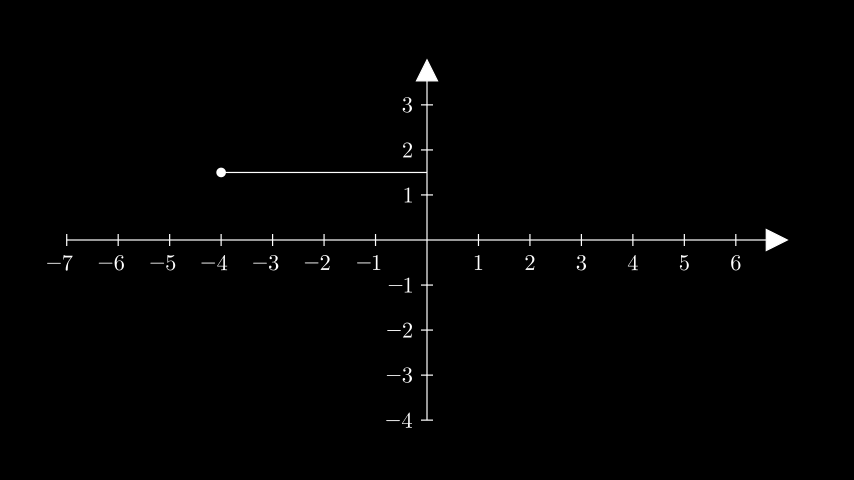
from manim import * class GetHorizontalLineExample(Scene): def construct(self): ax = Axes().add_coordinates() point = ax @ (-4, 1.5) dot = Dot(point) line = ax.get_horizontal_line(point, line_func=Line) self.add(ax, line, dot)
class GetHorizontalLineExample(Scene): def construct(self): ax = Axes().add_coordinates() point = ax @ (-4, 1.5) dot = Dot(point) line = ax.get_horizontal_line(point, line_func=Line) self.add(ax, line, dot)
- get_line_from_axis_to_point(index: int, point: Sequence[float], line_config: dict | None = None, color: ParsableManimColor | None = None, stroke_width: float = 2) DashedLine[source]¶
- get_line_from_axis_to_point(index: int, point: Sequence[float], line_func: type[LineType], line_config: dict | None = None, color: ParsableManimColor | None = None, stroke_width: float = 2) LineType
返回一条从给定轴到场景中一个点的直线。
- get_lines_to_point(point, **kwargs)[source]¶
生成从坐标轴到某点的水平线和垂直线。
- 参数:
point (Sequence[float]) – 场景中的一个点。
kwargs – 传递给
get_line_from_axis_to_point()的额外参数。
- 返回:
由水平线和垂直线组成的
VGroup。- 返回类型:
示例
示例:GetLinesToPointExample ¶
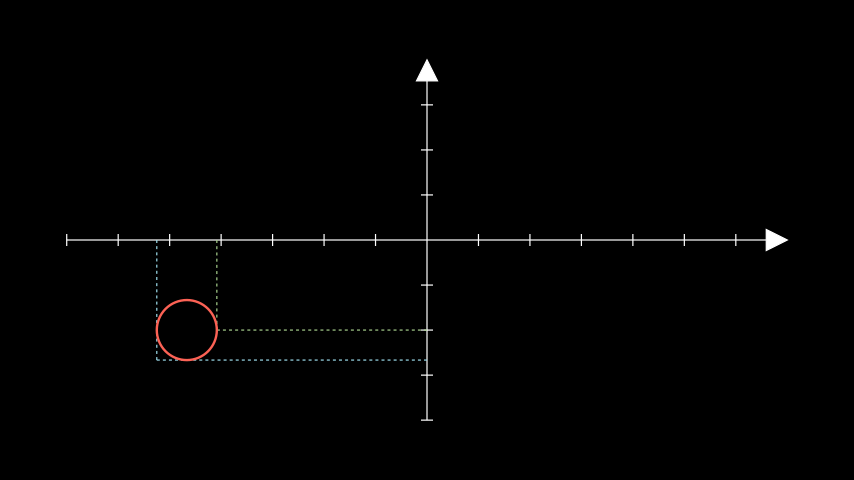
from manim import * class GetLinesToPointExample(Scene): def construct(self): ax = Axes() circ = Circle(radius=0.5).move_to([-4, -1.5, 0]) lines_1 = ax.get_lines_to_point(circ.get_right(), color=GREEN_B) lines_2 = ax.get_lines_to_point(circ.get_corner(DL), color=BLUE_B) self.add(ax, lines_1, lines_2, circ)
class GetLinesToPointExample(Scene): def construct(self): ax = Axes() circ = Circle(radius=0.5).move_to([-4, -1.5, 0]) lines_1 = ax.get_lines_to_point(circ.get_right(), color=GREEN_B) lines_2 = ax.get_lines_to_point(circ.get_corner(DL), color=BLUE_B) self.add(ax, lines_1, lines_2, circ)
- get_riemann_rectangles(graph, x_range=None, dx=0.1, input_sample_type='left', stroke_width=1, stroke_color=ManimColor('#000000'), fill_opacity=1, color=(ManimColor('#58C4DD'), ManimColor('#83C167')), show_signed_area=True, bounded_graph=None, blend=False, width_scale_factor=1.001)[source]¶
为给定曲线生成一组黎曼矩形的
VGroup对象。- 参数:
graph (ParametricFunction) – 将由黎曼矩形近似计算其面积的图。
x_range (Sequence[float] | None) – 矩形的最小和最大 x 值。
x_range = [x_min, x_max]。dx (float | None) – 分隔每个矩形的 x 值变化量。
input_sample_type (str) – 可以是
"left"、"right"或"center"之一。指每个黎曼矩形高度的采样点将位于分区段的何处。stroke_width (float) – 矩形边框的描边宽度。
stroke_color (ParsableManimColor) – 矩形边框的颜色。
fill_opacity (float) – 矩形的不透明度。
color (Iterable[ParsableManimColor] | ParsableManimColor) – 矩形的颜色。如果传入多种颜色,则创建平衡的渐变。
show_signed_area (bool) – 当曲线低于 x 轴时,通过反转颜色来表示负面积。
blend (bool) – 将
stroke_color设置为fill_color,使矩形融合而无明显分隔。bounded_graph (ParametricFunction) – 如果指定了第二个图,则围住两条曲线之间的区域。
width_scale_factor (float) – 矩形宽度缩放的因子。
- 返回:
包含黎曼矩形的
VGroup。- 返回类型:
示例
示例:GetRiemannRectanglesExample ¶
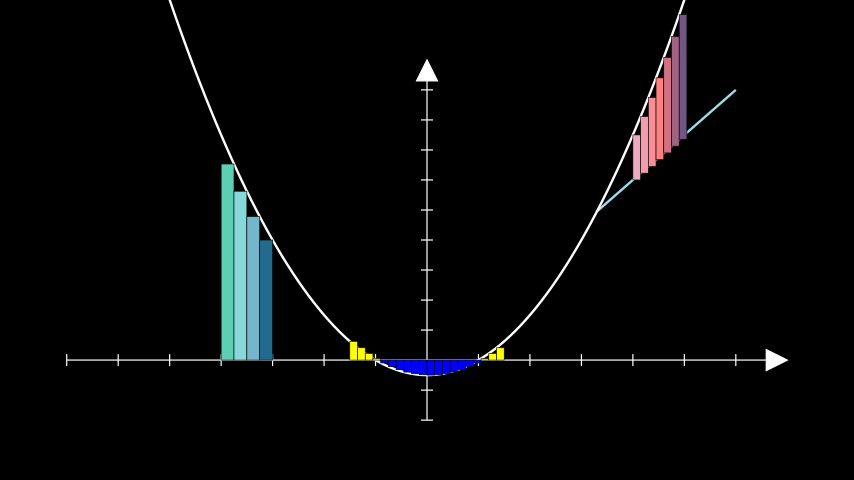
from manim import * class GetRiemannRectanglesExample(Scene): def construct(self): ax = Axes(y_range=[-2, 10]) quadratic = ax.plot(lambda x: 0.5 * x ** 2 - 0.5) # the rectangles are constructed from their top right corner. # passing an iterable to `color` produces a gradient rects_right = ax.get_riemann_rectangles( quadratic, x_range=[-4, -3], dx=0.25, color=(TEAL, BLUE_B, DARK_BLUE), input_sample_type="right", ) # the colour of rectangles below the x-axis is inverted # due to show_signed_area rects_left = ax.get_riemann_rectangles( quadratic, x_range=[-1.5, 1.5], dx=0.15, color=YELLOW ) bounding_line = ax.plot( lambda x: 1.5 * x, color=BLUE_B, x_range=[3.3, 6] ) bounded_rects = ax.get_riemann_rectangles( bounding_line, bounded_graph=quadratic, dx=0.15, x_range=[4, 5], show_signed_area=False, color=(MAROON_A, RED_B, PURPLE_D), ) self.add( ax, bounding_line, quadratic, rects_right, rects_left, bounded_rects )
class GetRiemannRectanglesExample(Scene): def construct(self): ax = Axes(y_range=[-2, 10]) quadratic = ax.plot(lambda x: 0.5 * x ** 2 - 0.5) # the rectangles are constructed from their top right corner. # passing an iterable to `color` produces a gradient rects_right = ax.get_riemann_rectangles( quadratic, x_range=[-4, -3], dx=0.25, color=(TEAL, BLUE_B, DARK_BLUE), input_sample_type="right", ) # the colour of rectangles below the x-axis is inverted # due to show_signed_area rects_left = ax.get_riemann_rectangles( quadratic, x_range=[-1.5, 1.5], dx=0.15, color=YELLOW ) bounding_line = ax.plot( lambda x: 1.5 * x, color=BLUE_B, x_range=[3.3, 6] ) bounded_rects = ax.get_riemann_rectangles( bounding_line, bounded_graph=quadratic, dx=0.15, x_range=[4, 5], show_signed_area=False, color=(MAROON_A, RED_B, PURPLE_D), ) self.add( ax, bounding_line, quadratic, rects_right, rects_left, bounded_rects )
- get_secant_slope_group(x, graph, dx=None, dx_line_color=ManimColor('#FFFF00'), dy_line_color=None, dx_label=None, dy_label=None, include_secant_line=True, secant_line_color=ManimColor('#83C167'), secant_line_length=10)[source]¶
- 创建两条代表dx和df的线,以及dx和df的标签,和
曲线上特定 x 值的割线。
- 参数:
x (float) – 割线首次与图相交的 x 值。
graph (ParametricFunction) – 将找到割线的曲线。
dx (float | None) – 割线离开后 x 的变化量。
dx_line_color (ParsableManimColor) – 指示 x 变化量的线的颜色。
dy_line_color (ParsableManimColor | None) – 指示 y 变化量的线的颜色。默认为
graph的颜色。dx_label (float | str | None) – dx 线的标签。对于
str和float输入,默认为MathTex。dy_label (float | str | None) – dy 线的标签。对于
str和float输入,默认为MathTex。include_secant_line (bool) – 是否在图中包含割线,或者只包含 df/dx 线和标签。
secant_line_color (ParsableManimColor) – 割线的颜色。
secant_line_length (float) – 割线的长度。
- 返回:
一个包含以下元素的组: dx_line、 df_line,如果适用,还包括
dx_label、df_label、 secant_line。- 返回类型:
示例
示例:GetSecantSlopeGroupExample ¶
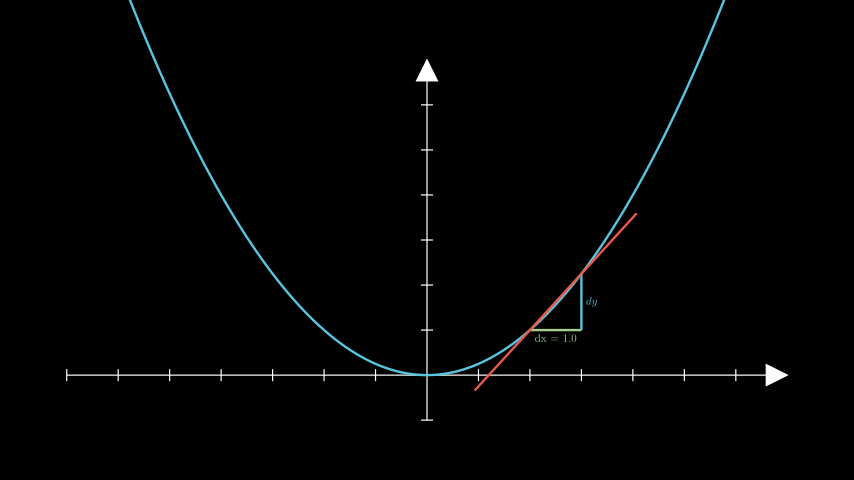
from manim import * class GetSecantSlopeGroupExample(Scene): def construct(self): ax = Axes(y_range=[-1, 7]) graph = ax.plot(lambda x: 1 / 4 * x ** 2, color=BLUE) slopes = ax.get_secant_slope_group( x=2.0, graph=graph, dx=1.0, dx_label=Tex("dx = 1.0"), dy_label="dy", dx_line_color=GREEN_B, secant_line_length=4, secant_line_color=RED_D, ) self.add(ax, graph, slopes)
class GetSecantSlopeGroupExample(Scene): def construct(self): ax = Axes(y_range=[-1, 7]) graph = ax.plot(lambda x: 1 / 4 * x ** 2, color=BLUE) slopes = ax.get_secant_slope_group( x=2.0, graph=graph, dx=1.0, dx_label=Tex("dx = 1.0"), dy_label="dy", dx_line_color=GREEN_B, secant_line_length=4, secant_line_color=RED_D, ) self.add(ax, graph, slopes)
- get_vertical_line(point, **kwargs)[source]¶
一条从x轴到场景中给定点的垂直线。
- 参数:
point (Sequence[float]) – 垂直线将绘制到的点。
kwargs (Any) – 传递给
get_line_from_axis_to_point的额外参数。
- 返回:
从 x 轴到该点的垂直线。
- 返回类型:
Line
示例
示例:GetVerticalLineExample ¶
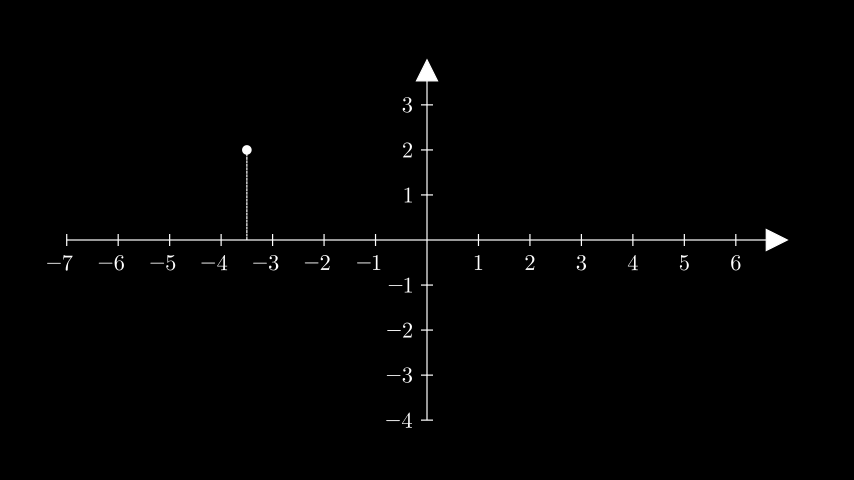
from manim import * class GetVerticalLineExample(Scene): def construct(self): ax = Axes().add_coordinates() point = ax.coords_to_point(-3.5, 2) dot = Dot(point) line = ax.get_vertical_line(point, line_config={"dashed_ratio": 0.85}) self.add(ax, line, dot)
class GetVerticalLineExample(Scene): def construct(self): ax = Axes().add_coordinates() point = ax.coords_to_point(-3.5, 2) dot = Dot(point) line = ax.get_vertical_line(point, line_config={"dashed_ratio": 0.85}) self.add(ax, line, dot)
- get_vertical_lines_to_graph(graph, x_range=None, num_lines=20, **kwargs)[source]¶
获取从x轴到曲线的多条线。
- 参数:
graph (ParametricFunction) – 线将沿其放置的图。
x_range (Sequence[float] | None) – 一个包含线段下限和上限的列表:
x_range = [x_min, x_max]。num_lines (int) – 等间距线的数量。
kwargs (Any) – 传递给
get_vertical_line()的额外参数。
- 返回:
等间距线的
VGroup。- 返回类型:
示例
示例:GetVerticalLinesToGraph ¶
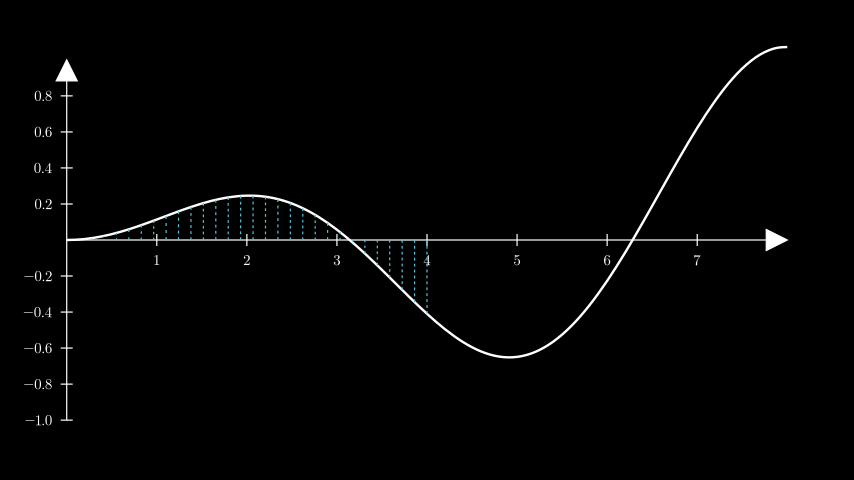
from manim import * class GetVerticalLinesToGraph(Scene): def construct(self): ax = Axes( x_range=[0, 8.0, 1], y_range=[-1, 1, 0.2], axis_config={"font_size": 24}, ).add_coordinates() curve = ax.plot(lambda x: np.sin(x) / np.e ** 2 * x) lines = ax.get_vertical_lines_to_graph( curve, x_range=[0, 4], num_lines=30, color=BLUE ) self.add(ax, curve, lines)
class GetVerticalLinesToGraph(Scene): def construct(self): ax = Axes( x_range=[0, 8.0, 1], y_range=[-1, 1, 0.2], axis_config={"font_size": 24}, ).add_coordinates() curve = ax.plot(lambda x: np.sin(x) / np.e ** 2 * x) lines = ax.get_vertical_lines_to_graph( curve, x_range=[0, 4], num_lines=30, color=BLUE ) self.add(ax, curve, lines)
- get_x_axis_label(label, edge=array([1., 1., 0.]), direction=array([1., 1., 0.]), buff=0.1, **kwargs)[source]¶
生成x轴标签。
- 参数:
- 返回:
已定位的标签。
- 返回类型:
示例
示例:GetXAxisLabelExample ¶
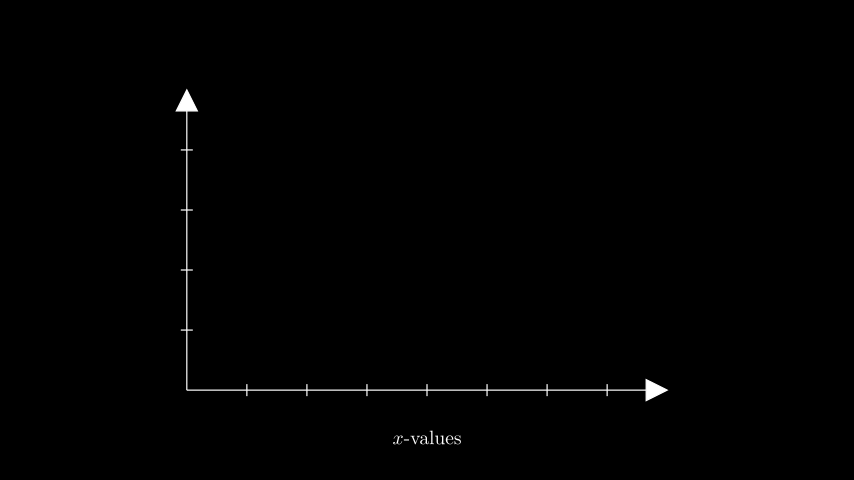
from manim import * class GetXAxisLabelExample(Scene): def construct(self): ax = Axes(x_range=(0, 8), y_range=(0, 5), x_length=8, y_length=5) x_label = ax.get_x_axis_label( Tex("$x$-values").scale(0.65), edge=DOWN, direction=DOWN, buff=0.5 ) self.add(ax, x_label)
class GetXAxisLabelExample(Scene): def construct(self): ax = Axes(x_range=(0, 8), y_range=(0, 5), x_length=8, y_length=5) x_label = ax.get_x_axis_label( Tex("$x$-values").scale(0.65), edge=DOWN, direction=DOWN, buff=0.5 ) self.add(ax, x_label)
- get_y_axis_label(label, edge=array([1., 1., 0.]), direction=array([1., 0.5, 0.]), buff=0.1, **kwargs)[source]¶
生成y轴标签。
- 参数:
- 返回:
已定位的标签。
- 返回类型:
示例
示例:GetYAxisLabelExample ¶
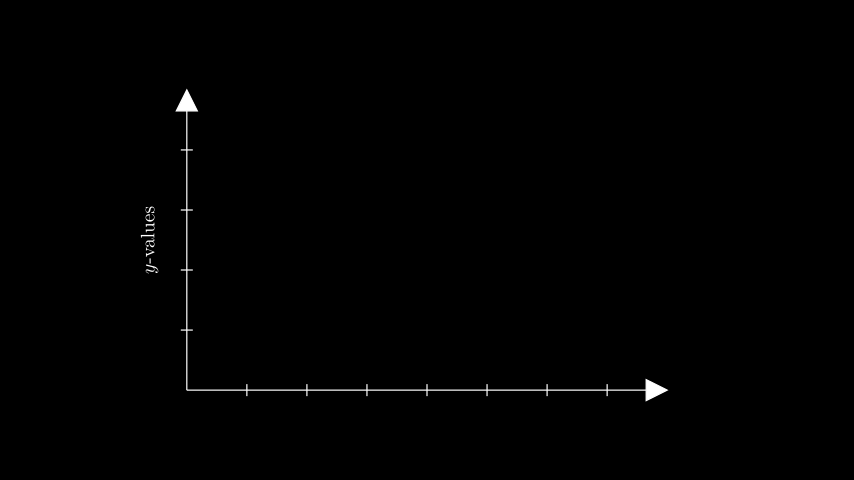
from manim import * class GetYAxisLabelExample(Scene): def construct(self): ax = Axes(x_range=(0, 8), y_range=(0, 5), x_length=8, y_length=5) y_label = ax.get_y_axis_label( Tex("$y$-values").scale(0.65).rotate(90 * DEGREES), edge=LEFT, direction=LEFT, buff=0.3, ) self.add(ax, y_label)
class GetYAxisLabelExample(Scene): def construct(self): ax = Axes(x_range=(0, 8), y_range=(0, 5), x_length=8, y_length=5) y_label = ax.get_y_axis_label( Tex("$y$-values").scale(0.65).rotate(90 * DEGREES), edge=LEFT, direction=LEFT, buff=0.3, ) self.add(ax, y_label)
- i2gc(x, graph)[source]¶
-
- 参数:
x (float)
graph (ParametricFunction)
- 返回类型:
tuple[float, float]
- i2gp(x, graph)[source]¶
-
- 参数:
x (float)
graph (ParametricFunction)
- 返回类型:
ndarray
- input_to_graph_coords(x, graph)[source]¶
根据给定的x值,返回图上点的轴相对坐标的元组。
示例
>>> from manim import Axes >>> ax = Axes() >>> parabola = ax.plot(lambda x: x**2) >>> ax.input_to_graph_coords(x=3, graph=parabola) (3, 9)
- 参数:
x (float)
graph (ParametricFunction)
- 返回类型:
tuple[float, float]
- input_to_graph_point(x, graph)[source]¶
返回
graph上对应于x值的点的坐标。- 参数:
x (float) –
graph上一个点的 x 值。graph (ParametricFunction | VMobject) – 点所在的
ParametricFunction。
- 返回:
graph上对应x值的点的坐标。- 返回类型:
np.ndarray- 抛出:
ValueError – 当目标 x 不在线图的范围内时。
示例
示例:InputToGraphPointExample ¶
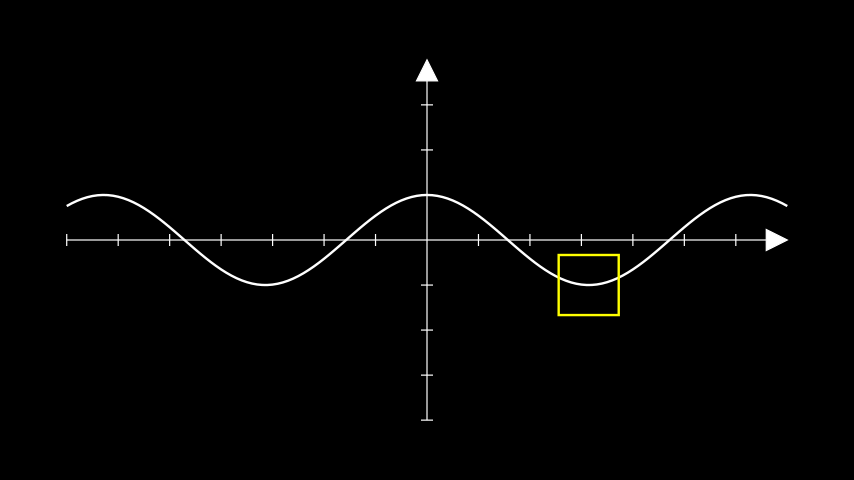
from manim import * class InputToGraphPointExample(Scene): def construct(self): ax = Axes() curve = ax.plot(lambda x : np.cos(x)) # move a square to PI on the cosine curve. position = ax.input_to_graph_point(x=PI, graph=curve) sq = Square(side_length=1, color=YELLOW).move_to(position) self.add(ax, curve, sq)
class InputToGraphPointExample(Scene): def construct(self): ax = Axes() curve = ax.plot(lambda x : np.cos(x)) # move a square to PI on the cosine curve. position = ax.input_to_graph_point(x=PI, graph=curve) sq = Square(side_length=1, color=YELLOW).move_to(position) self.add(ax, curve, sq)
- p2c(point)[source]¶
point_to_coords()的缩写。- 参数:
point (Point3DLike)
- plot(function, x_range=None, use_vectorized=False, colorscale=None, colorscale_axis=1, **kwargs)[source]¶
根据函数生成曲线。
- 参数:
function (Callable[[float], float]) – 用于构建
ParametricFunction的函数。x_range (Sequence[float] | None) – 曲线沿坐标轴的范围。
x_range = [x_min, x_max, x_step]。use_vectorized (bool) – 是否将生成的 t 值数组传递给函数。仅当您的函数支持此功能时才使用。输出应为形状为
[y_0, y_1, ...]的 numpy 数组。colorscale (Union[Iterable[Color], Iterable[Color, float]] | ParsableManimColor) – 函数的颜色。根据值对函数着色时使用的可选参数。传入颜色列表和 colorscale_axis 将根据 y 值对函数着色。传入
(color, pivot)形式的元组列表允许用户定义颜色过渡的枢轴点。colorscale_axis (int) – 定义应用颜色刻度线的坐标轴(0 = x,1 = y),默认为 y 轴 (1)。
kwargs (Any) – 传递给
ParametricFunction的额外参数。
- 返回:
绘制的曲线。
- 返回类型:
警告
此方法可能无法生成精确的图表,因为 Manim 目前依赖于曲线等距采样点之间的插值,而非智能绘图。有关此问题的一些解决方案,请参见以下示例。
示例
示例:PlotExample ¶

from manim import * class PlotExample(Scene): def construct(self): # construct the axes ax_1 = Axes( x_range=[0.001, 6], y_range=[-8, 2], x_length=5, y_length=3, tips=False, ) ax_2 = ax_1.copy() ax_3 = ax_1.copy() # position the axes ax_1.to_corner(UL) ax_2.to_corner(UR) ax_3.to_edge(DOWN) axes = VGroup(ax_1, ax_2, ax_3) # create the logarithmic curves def log_func(x): return np.log(x) # a curve without adjustments; poor interpolation. curve_1 = ax_1.plot(log_func, color=PURE_RED) # disabling interpolation makes the graph look choppy as not enough # inputs are available curve_2 = ax_2.plot(log_func, use_smoothing=False, color=ORANGE) # taking more inputs of the curve by specifying a step for the # x_range yields expected results, but increases rendering time. curve_3 = ax_3.plot( log_func, x_range=(0.001, 6, 0.001), color=PURE_GREEN ) curves = VGroup(curve_1, curve_2, curve_3) self.add(axes, curves)
class PlotExample(Scene): def construct(self): # construct the axes ax_1 = Axes( x_range=[0.001, 6], y_range=[-8, 2], x_length=5, y_length=3, tips=False, ) ax_2 = ax_1.copy() ax_3 = ax_1.copy() # position the axes ax_1.to_corner(UL) ax_2.to_corner(UR) ax_3.to_edge(DOWN) axes = VGroup(ax_1, ax_2, ax_3) # create the logarithmic curves def log_func(x): return np.log(x) # a curve without adjustments; poor interpolation. curve_1 = ax_1.plot(log_func, color=PURE_RED) # disabling interpolation makes the graph look choppy as not enough # inputs are available curve_2 = ax_2.plot(log_func, use_smoothing=False, color=ORANGE) # taking more inputs of the curve by specifying a step for the # x_range yields expected results, but increases rendering time. curve_3 = ax_3.plot( log_func, x_range=(0.001, 6, 0.001), color=PURE_GREEN ) curves = VGroup(curve_1, curve_2, curve_3) self.add(axes, curves)
- plot_antiderivative_graph(graph, y_intercept=0, samples=50, use_vectorized=False, **kwargs)[source]¶
绘制反导数图。
- 参数:
graph (ParametricFunction) – 用于计算反导数的图。
y_intercept (float) – 图形与y轴的截距的y值。
samples (int) – 用于计算图下面积的点数。
use_vectorized (bool) – 是否使用反导数的向量化版本。这意味着将生成的 t 值数组传递给函数。仅当您的函数支持时才使用此选项。输出应为形状为
[y_0, y_1, ...]的 numpy 数组。kwargs (Any) –
ParametricFunction的任何有效关键字参数。
- 返回:
反导数的曲线。
- 返回类型:
注意
此图是从参考图下方的面积值绘制的。如果参考图包含从 x=0 起无法计算的面积,则结果可能不理想。
示例
示例:AntiderivativeExample ¶
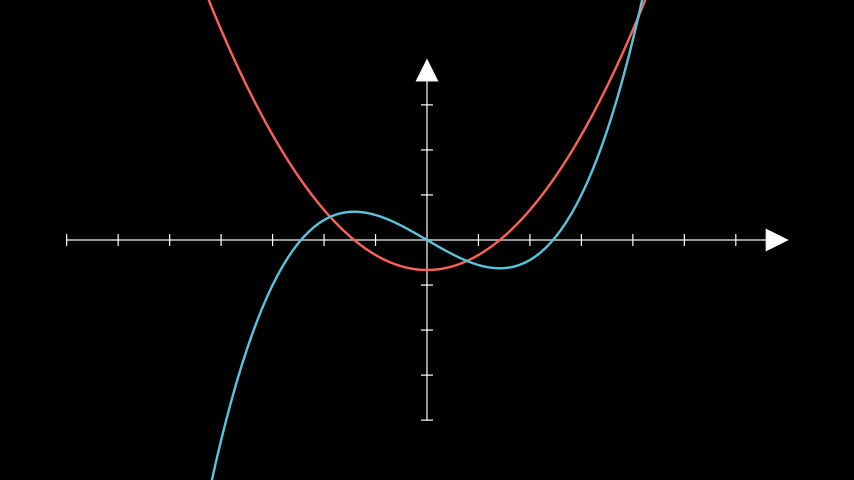
from manim import * class AntiderivativeExample(Scene): def construct(self): ax = Axes() graph1 = ax.plot( lambda x: (x ** 2 - 2) / 3, color=RED, ) graph2 = ax.plot_antiderivative_graph(graph1, color=BLUE) self.add(ax, graph1, graph2)
class AntiderivativeExample(Scene): def construct(self): ax = Axes() graph1 = ax.plot( lambda x: (x ** 2 - 2) / 3, color=RED, ) graph2 = ax.plot_antiderivative_graph(graph1, color=BLUE) self.add(ax, graph1, graph2)
- plot_derivative_graph(graph, color=ManimColor('#83C167'), **kwargs)[source]¶
返回所传递图形的导数曲线。
- 参数:
graph (ParametricFunction) – 用于计算导数的图。
color (ParsableManimColor) – 导数曲线的颜色。
kwargs –
ParametricFunction的任何有效关键字参数。
- 返回:
导数的曲线。
- 返回类型:
示例
示例:DerivativeGraphExample ¶
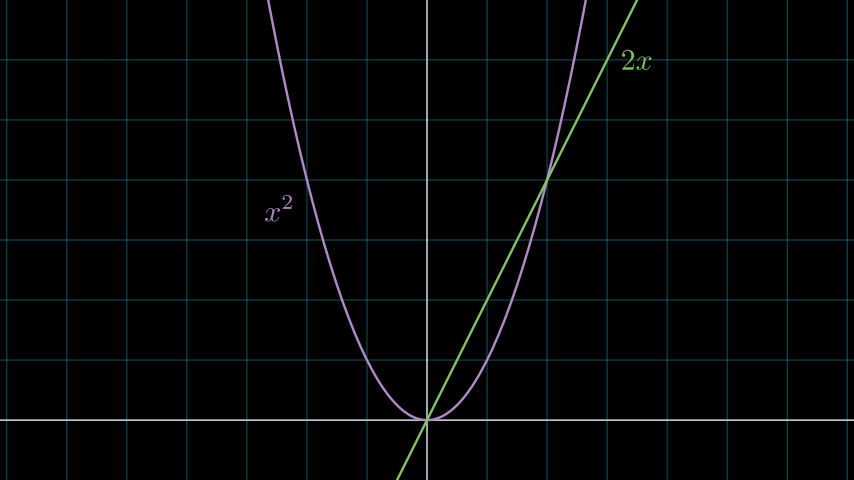
from manim import * class DerivativeGraphExample(Scene): def construct(self): ax = NumberPlane(y_range=[-1, 7], background_line_style={"stroke_opacity": 0.4}) curve_1 = ax.plot(lambda x: x ** 2, color=PURPLE_B) curve_2 = ax.plot_derivative_graph(curve_1) curves = VGroup(curve_1, curve_2) label_1 = ax.get_graph_label(curve_1, "x^2", x_val=-2, direction=DL) label_2 = ax.get_graph_label(curve_2, "2x", x_val=3, direction=RIGHT) labels = VGroup(label_1, label_2) self.add(ax, curves, labels)
class DerivativeGraphExample(Scene): def construct(self): ax = NumberPlane(y_range=[-1, 7], background_line_style={"stroke_opacity": 0.4}) curve_1 = ax.plot(lambda x: x ** 2, color=PURPLE_B) curve_2 = ax.plot_derivative_graph(curve_1) curves = VGroup(curve_1, curve_2) label_1 = ax.get_graph_label(curve_1, "x^2", x_val=-2, direction=DL) label_2 = ax.get_graph_label(curve_2, "2x", x_val=3, direction=RIGHT) labels = VGroup(label_1, label_2) self.add(ax, curves, labels)
- plot_implicit_curve(func, min_depth=5, max_quads=1500, **kwargs)[source]¶
创建隐函数的曲线。
- 参数:
func (Callable[[float, float], float]) – 要绘制的函数,形式为 f(x, y) = 0。
min_depth (int) – 函数计算的最小深度。
max_quads (int) – 要使用的最大四边形数量。
kwargs (Any) – 传递给
ImplicitFunction的额外参数。
- 返回类型:
示例
示例:ImplicitExample ¶
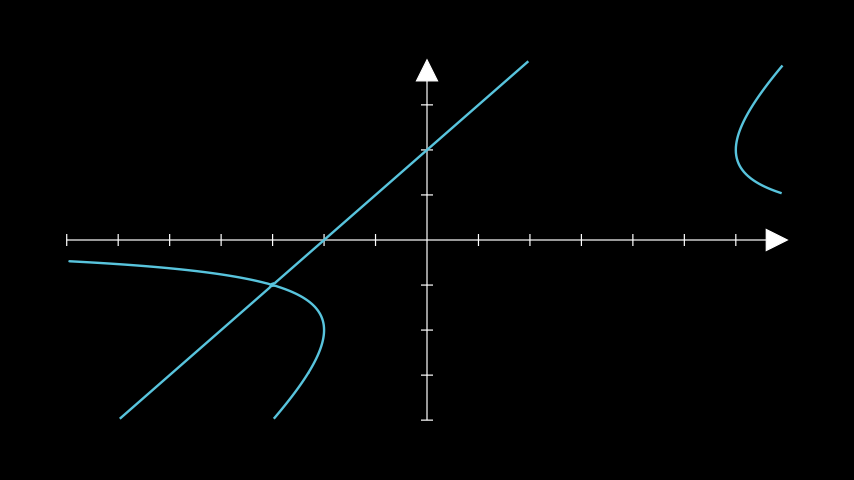
from manim import * class ImplicitExample(Scene): def construct(self): ax = Axes() a = ax.plot_implicit_curve( lambda x, y: y * (x - y) ** 2 - 4 * x - 8, color=BLUE ) self.add(ax, a)
class ImplicitExample(Scene): def construct(self): ax = Axes() a = ax.plot_implicit_curve( lambda x, y: y * (x - y) ** 2 - 4 * x - 8, color=BLUE ) self.add(ax, a)
- plot_parametric_curve(function, use_vectorized=False, **kwargs)[source]¶
一条参数曲线。
- 参数:
function (Callable[[float], ndarray]) – 一个将数字映射到坐标系中点的参数函数。
use_vectorized (bool) – 是否将生成的 t 值数组传递给函数。仅当您的函数支持时才使用此选项。
kwargs (Any) – 任何其他关键字参数都将传递给
ParametricFunction。
- 返回类型:
示例
示例:ParametricCurveExample ¶
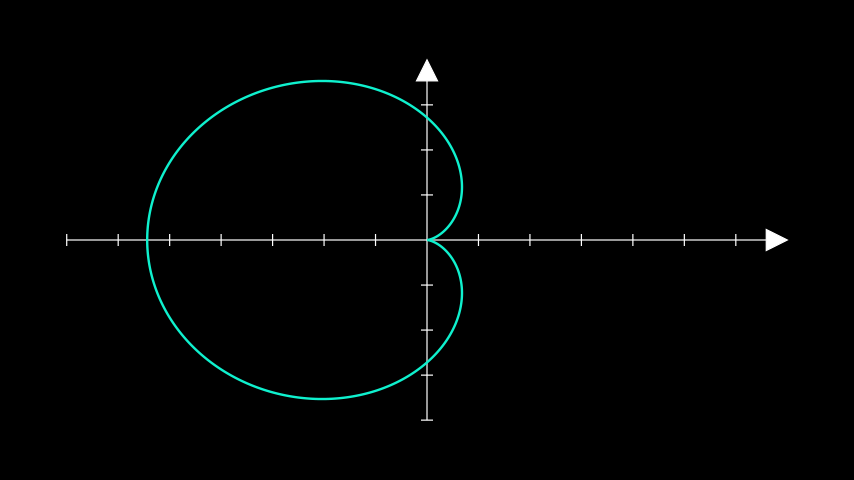
from manim import * class ParametricCurveExample(Scene): def construct(self): ax = Axes() cardioid = ax.plot_parametric_curve( lambda t: np.array( [ np.exp(1) * np.cos(t) * (1 - np.cos(t)), np.exp(1) * np.sin(t) * (1 - np.cos(t)), 0, ] ), t_range=[0, 2 * PI], color="#0FF1CE", ) self.add(ax, cardioid)
class ParametricCurveExample(Scene): def construct(self): ax = Axes() cardioid = ax.plot_parametric_curve( lambda t: np.array( [ np.exp(1) * np.cos(t) * (1 - np.cos(t)), np.exp(1) * np.sin(t) * (1 - np.cos(t)), 0, ] ), t_range=[0, 2 * PI], color="#0FF1CE", ) self.add(ax, cardioid)
- plot_polar_graph(r_func, theta_range=None, **kwargs)[source]¶
极坐标图。
- 参数:
r_func (Callable[[float], float]) – r 对 theta 的函数。
theta_range (Sequence[float] | None) – theta 的范围,格式为
theta_range = [theta_min, theta_max, theta_step]。kwargs (Any) – 传递给
ParametricFunction的额外参数。
- 返回类型:
示例
示例:PolarGraphExample ¶
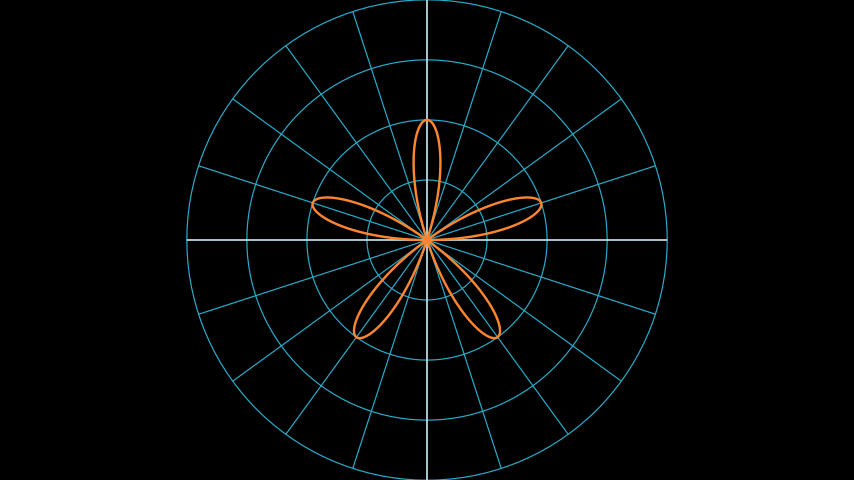
from manim import * class PolarGraphExample(Scene): def construct(self): plane = PolarPlane() r = lambda theta: 2 * np.sin(theta * 5) graph = plane.plot_polar_graph(r, [0, 2 * PI], color=ORANGE) self.add(plane, graph)
class PolarGraphExample(Scene): def construct(self): plane = PolarPlane() r = lambda theta: 2 * np.sin(theta * 5) graph = plane.plot_polar_graph(r, [0, 2 * PI], color=ORANGE) self.add(plane, graph)参考:
PolarPlane
- plot_surface(function, u_range=None, v_range=None, colorscale=None, colorscale_axis=2, **kwargs)[source]¶
根据函数生成曲面。
- 参数:
function (Callable[[float], float]) – 用于构建
Surface的函数。u_range (Sequence[float] | None) –
u变量的范围:(u_min, u_max)。v_range (Sequence[float] | None) –
v变量的范围:(v_min, v_max)。colorscale (Sequence[ParsableManimColor] | Sequence[tuple[ParsableManimColor, float]] | None) – 曲面的颜色。传入颜色列表将按 z 值对曲面着色。传入
(color, pivot)形式的元组列表允许用户定义颜色过渡的枢轴点。colorscale_axis (int) – 定义应用颜色刻度轴(0 = x,1 = y,2 = z),默认为 z 轴 (2)。
kwargs (Any) – 传递给
Surface的额外参数。
- 返回:
绘制的曲面。
- 返回类型:
示例
示例:PlotSurfaceExample ¶
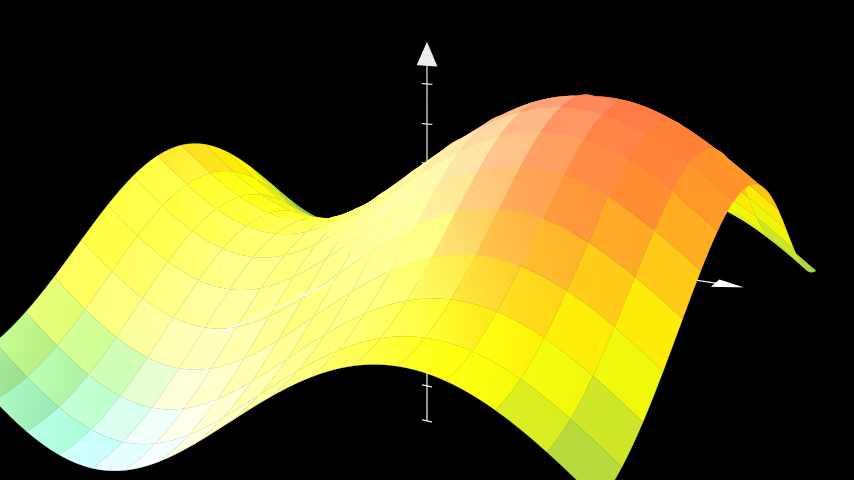
from manim import * class PlotSurfaceExample(ThreeDScene): def construct(self): resolution_fa = 16 self.set_camera_orientation(phi=75 * DEGREES, theta=-60 * DEGREES) axes = ThreeDAxes(x_range=(-3, 3, 1), y_range=(-3, 3, 1), z_range=(-5, 5, 1)) def param_trig(u, v): x = u y = v z = 2 * np.sin(x) + 2 * np.cos(y) return z trig_plane = axes.plot_surface( param_trig, resolution=(resolution_fa, resolution_fa), u_range = (-3, 3), v_range = (-3, 3), colorscale = [BLUE, GREEN, YELLOW, ORANGE, RED], ) self.add(axes, trig_plane)
class PlotSurfaceExample(ThreeDScene): def construct(self): resolution_fa = 16 self.set_camera_orientation(phi=75 * DEGREES, theta=-60 * DEGREES) axes = ThreeDAxes(x_range=(-3, 3, 1), y_range=(-3, 3, 1), z_range=(-5, 5, 1)) def param_trig(u, v): x = u y = v z = 2 * np.sin(x) + 2 * np.cos(y) return z trig_plane = axes.plot_surface( param_trig, resolution=(resolution_fa, resolution_fa), u_range = (-3, 3), v_range = (-3, 3), colorscale = [BLUE, GREEN, YELLOW, ORANGE, RED], ) self.add(axes, trig_plane)
- point_to_polar(point)[source]¶
从点获取极坐标。
- 参数:
point (Point2DLike) – 该点。
- 返回:
坐标半径 (\(r\)) 和坐标方位角 (\(\theta\))。
- 返回类型:
Tuple[
float,float]
- polar_to_point(radius, azimuth)[source]¶
从极坐标获取一个点。
- 参数:
radius (float) – 坐标半径 (\(r\))。
azimuth (float) – 坐标方位角 (\(\theta\))。
- 返回:
该点。
- 返回类型:
numpy.ndarray
示例
示例:PolarToPointExample ¶
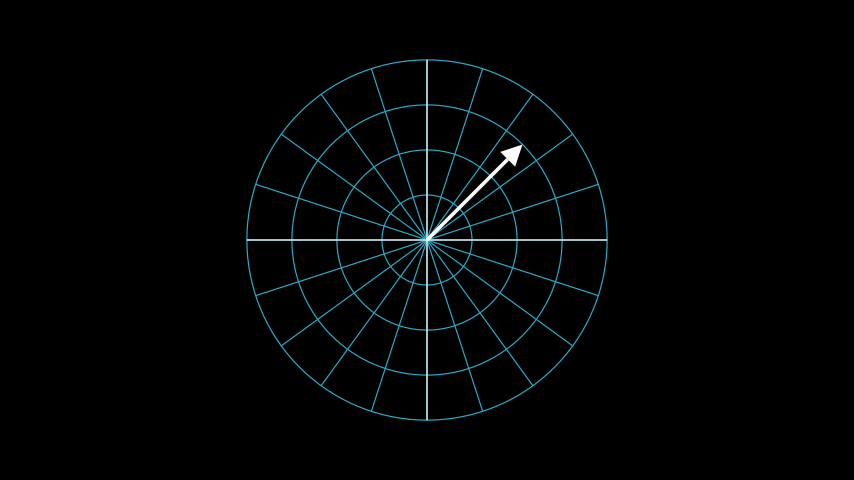
from manim import * class PolarToPointExample(Scene): def construct(self): polarplane_pi = PolarPlane(azimuth_units="PI radians", size=6) polartopoint_vector = Vector(polarplane_pi.polar_to_point(3, PI/4)) self.add(polarplane_pi) self.add(polartopoint_vector)
class PolarToPointExample(Scene): def construct(self): polarplane_pi = PolarPlane(azimuth_units="PI radians", size=6) polartopoint_vector = Vector(polarplane_pi.polar_to_point(3, PI/4)) self.add(polarplane_pi) self.add(polartopoint_vector)参考:
PolarPlaneVector
- pr2pt(radius, azimuth)[source]¶
polar_to_point()的缩写。- 参数:
radius (float)
azimuth (float)
- 返回类型:
ndarray
- pt2pr(point)[source]¶
point_to_polar()的缩写。- 参数:
point (ndarray)
- 返回类型:
tuple[float, float]
- slope_of_tangent(x, graph, **kwargs)[source]¶
返回在特定x值处,绘制曲线的切线的斜率。
- 参数:
x (float) – 切线必须与曲线相切的x值。
graph (ParametricFunction) – 用于计算切线的
ParametricFunction。kwargs (Any)
- 返回:
切线与 x 轴的斜率。
- 返回类型:
浮点数
示例
ax = Axes() curve = ax.plot(lambda x: x**2) ax.slope_of_tangent(x=-2, graph=curve) # -3.5000000259052038